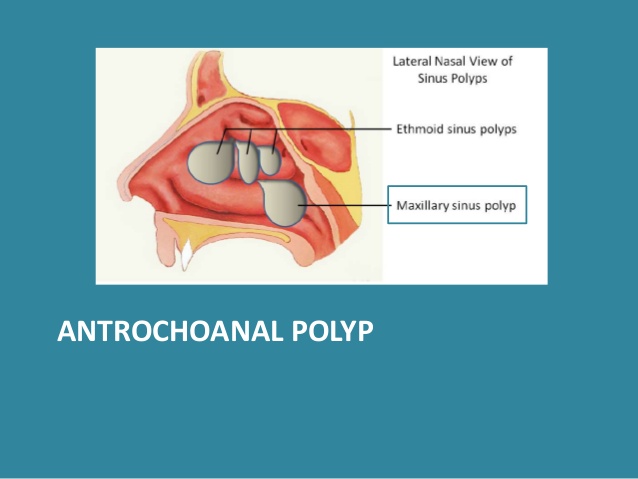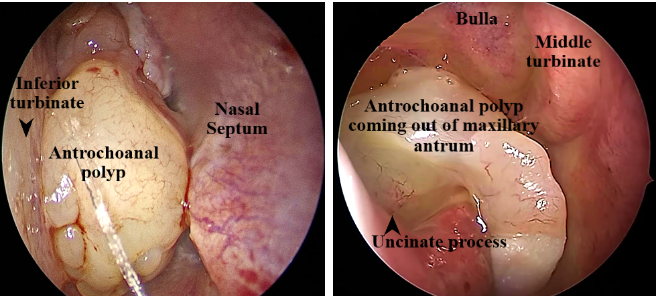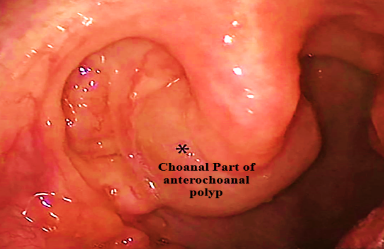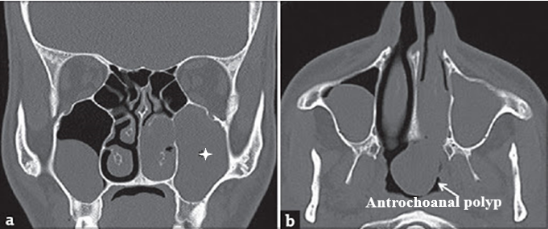
ANTROCHOANAL POLYP
Definition: Antrochoanal nasal polyp is a prolapsed, pedunculated, painless, pearly white oedematous nasal mucosa, lining the maxillary sinus. It is also called Killian’s polyp.
Aetiology:
-
- Age: Antrochoanal nasal polyp is common in children and young adults.
- Infection: Antrochoanal polyps have infective aetiology.
- Other theories:a) Bernoulli’s phenomenon due to negative pressure. b) Polysaccharide changes of ground substance. c) Vasomotor imbalance.
- Antral, which is a thin stalk.
- Choanal, which is round and globular. It is the largest part.
- Nasal, which is flat from side to side.
Symptoms:
a) Nasal obstruction: It is usually unilateral not relieved by nasal decongestant drops. Obstruction may become bilateral when polyp grows into the nasopharynx and starts obstructing the opposite choana.
b) Nasal discharge: It is unilateral, mucopurulent and occasionally blood tinged.
c) Postnasal drip: It is present and mucopurulent in nature.
b) Nasal discharge: It is unilateral, mucopurulent and occasionally blood tinged.
c) Postnasal drip: It is present and mucopurulent in nature.
Many patients come to the specialist with a chronic cold, quite unaware that they may be having an antrochoanal polyp.
Signs:
a) On Anterior rhinoscopy- A smooth greyish mass covered with nasal discharge may be seen. It is soft and can be moved up and down with a probe.

b) Posterior rhinoscopy may present with a globular mass filling the choana or the nasopharynx. It may hang down behind the soft palate and present in the oropharynx when it is very large in size.

c) Rhinolalia Clausa: Present due to nasal obstruction.
d) Broadening of nasal bridge.
Investigations:
a) X-ray of Paranasal Sinuses: This will show the extent of the disease in the sinuses. A polyp seen as a soft tissue shadow in maxillary sinus with convexity upwards.
b) CT Scan of the Paranasal Sinuses: This is the investigation of choice, prior to surgery. CT Scan reveals the extent of the disease, orbital involvement and vascularity. It is mandatory in revision cases due altered anatomy.
b) CT Scan of the Paranasal Sinuses: This is the investigation of choice, prior to surgery. CT Scan reveals the extent of the disease, orbital involvement and vascularity. It is mandatory in revision cases due altered anatomy.

Treatment:
Medical management
- Medical treatment consists mainly of topical and systemic corticosteroids.
➣ It affects the eosinophil function directly by reducing both eosinophil viability and activation and indirectly by reducing the secretion of chemotactic cytokines by nasal mucosa and polyp epithelial cells.
➣ The effect of nasal spray on sense of smell is poor when compared to systemic steroids, which may be due to the sprays being unable to reach the olfactory mucosa because of oedema.
➣ Nasal drops are more effective than sprays and have a significant positive effect on sense of smell.
➣ Topical steroids may be used but not more than 2 months at one time unless under specialist supervision or for not longer than 4 months in one 12-month period, as they can be absorbed systemically.
➣ Larger polyps may require systemic corticosteroids like prednisolone 0.5 mg/kg each morning for 5–10 days. Maintenance therapy with topical corticosteroid spray is recommended as these may have lower bioavailability than drops. - Antihistamines can be given if allergy is present.
- Leukotriene inhibitors help patients with coexisting asthma and/or aspirin sensitivity.
- Antibiotics- A 3-month course of a macrolide antibiotic can help nasal polyps.
Surgical Management
This is treatment of choice mainly for well-formed polyps.
- Functional Endoscopic Sinus Surgery (FESS):
➣ It is the treatment of choice and can be done along with microdebrider.
➣ Aims to improve sinus ventilation and drainage as well as removing polyps.
➣ The extent of surgery varies with the extent of disease. The surgeon’s experience and available technology adds to the finesse of surgery.
➣ Now a days coblation is also used with microdebrider to remove the polyp from nasal cavity. The microshaver has different angled blades that have access in difficult areas of the sinuses.
➣ Postoperatively, patients should be treated with nasal douching and intranasal or systemic corticosteroids. - Caldwell Luc Surgery: Rarely done now a days. Performed only for recurrent antrochoanal polyposis.
- Nasal Polypectomy: Polyps are avulsed using nasal snare. However, the basic pathology in the sinuses is not eliminated.
We Are Always Ready to Help You.
Book An Appointment

